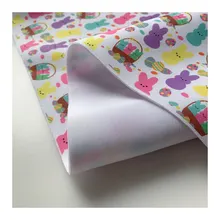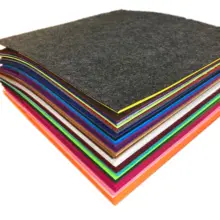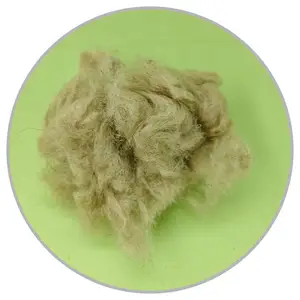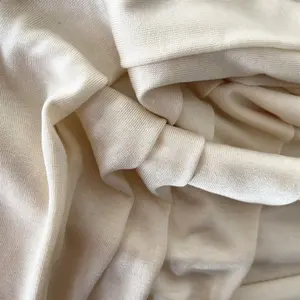Silk hemp yarn is a distinctive textile fiber known for its durability, natural luster, and soft texture. This yarn is a blend of silk and hemp fibers, offering a unique combination of properties that make it highly sought after in the textile industry. The integration of silk provides a smooth, luxurious feel, while hemp contributes to the yarn's strength and eco-friendly attributes.
Types and Composition of Silk Hemp Yarn
The silk hemp yarn market offers a variety of blends, each with its unique characteristics to serve different purposes. For instance, the blend of 50% cotton, 20% lyocell Tencel, 15% hemp, and 15% silk is renowned for its exceptional softness and strength, making it an excellent choice for high-quality apparel. On the other hand, the 1/48NM bright silk hemp yarn, which includes a significant proportion of polyester, is prized for its glossy finish and lightweight nature, perfect for creating airy and elegant summer wear. There are also yarns with a higher hemp content, which are particularly robust and suitable for crafting durable items such as bags and home textiles. Each blend is carefully engineered to maximize the benefits of each component fiber, resulting in a versatile and high-performing yarn. The natural color dyed hemp yarn, which blends heavenly silkworm silk with viscose and nylon, offers a sustainable option that does not compromise on the silky texture and strength desired in luxury textiles.
Structural Integrity and Technics of Silk Hemp Yarn
The structural integrity of silk hemp yarn is a testament to the sophisticated spinning techniques employed in its creation. The ring-spun method compacts the fibers tightly together, enhancing the yarn's smoothness and strength, which is crucial for fine weaving and detailed embroidery. Open-end spinning, while faster, creates a loftier yarn with a more pronounced texture, ideal for bulkier knitwear. The physical components of the yarn, such as the twist level and the fiber alignment, are meticulously controlled during production to ensure uniformity and optimal performance during textile manufacturing. The yarn's structure is also designed to minimize friction, allowing for smoother knitting and weaving processes, which is particularly beneficial in industrial settings where efficiency and speed are paramount.
Material Benefits and Features of Silk Hemp Yarn
The choice of materials in silk hemp yarn is deliberate, aiming to harness the inherent properties of silk and hemp. Silk's natural sheen and drape make it a favorite for luxury garments, while hemp's tensile strength and mildew resistance make it suitable for outdoor and workwear. The materials are also chosen for their environmental benefits; hemp is a sustainable crop that requires minimal pesticides and water, and silk, while a natural protein fiber, is biodegradable. These materials, when combined, create a yarn that is not only functional and beautiful but also kind to the planet. The anti-pilling nature of the yarn ensures that fabrics maintain their aesthetic appeal over time, while the anti-static property is crucial for comfort in clothing, especially in dry environments.
Applications and Business Usages of Silk Hemp Yarn
Silk hemp yarn is utilized across various industries, from fashion to home furnishings. In the fashion industry, its hypoallergenic and breathable nature makes it a staple for creating comfortable, all-season clothing. In interior design, its durability translates into long-lasting upholstery fabrics and window treatments. The yarn's versatility has also been embraced by the craft community, where it is used in creating unique hand-knitted items. Businesses value silk hemp yarn for its ability to blend luxury with practicality, offering products that are both high-end and durable. The moisture-absorbent feature of the yarn also makes it particularly suitable for activewear and outdoor gear, where managing perspiration and comfort is essential.
Functions and Tasks of Silk Hemp Yarn
The primary function of silk hemp yarn is to provide a versatile material that can be woven or knitted into textiles. It is designed to perform a variety of tasks, from forming the basis of sturdy, wear-resistant work clothes to delicate, luxurious evening wear. The yarn's adaptability also makes it suitable for a range of decorative purposes, such as tapestries and artisanal crafts, showcasing its broad functional spectrum. Its recyclable nature further allows it to be repurposed at the end of its lifecycle, reducing waste and promoting sustainable practices within the textile industry.
Distinct Characteristics and Capabilities of Silk Hemp Yarn
The distinct characteristics of silk hemp yarn lie in its unique blend of fibers, which offer a balance of softness and resilience. Its capabilities extend beyond traditional yarns with its natural antibacterial and antifungal properties, making it a healthier choice for skin contact textiles. Additionally, its low elasticity ensures that garments maintain their shape over time, a unique selling point that sets it apart from other natural fibers. The yarn's ability to be bleached allows for a wide range of color options, providing designers with creative freedom in their work.
Benefits and Positive Outcomes of Silk Hemp Yarn
The benefits of silk hemp yarn are manifold. For the end-user, it offers a hypoallergenic, comfortable fabric that adapts to different climates and uses. For the manufacturer, it provides a durable, easy-to-dye medium that holds up well during the production process. The environmental advantage of using a renewable resource like hemp, which enriches the soil it grows in, offers a compelling narrative for brands focusing on sustainability. The strong nature of the yarn also means less breakage during the production process, leading to less waste and more efficient manufacturing.
How to Choose the Right Silk Hemp Yarn?
Choosing the right silk hemp yarn involves considering the end product's desired attributes. For a softer feel, a higher silk ratio is recommended, while for more structural items, a higher hemp content may be beneficial. It's also important to consider the yarn's weight and ply, as these will affect the texture and drape of the finished textile. The color and pattern of the yarn, such as whether it is bleached or melange, can also influence the aesthetic of the final product, making these factors crucial in the selection process.
How to Maintain and Care for Silk Hemp Yarn Products?
Caring for silk hemp yarn products involves gentle handling. Washing in cold water with mild detergents and laying flat to dry can help preserve the fabric's integrity. Avoiding harsh chemicals and high heat will extend the life of products made from this yarn. For items that are heavily used, such as home textiles, periodic professional cleaning may be beneficial to maintain their appearance and longevity.
How to Install Silk Hemp Yarn in Textile Production?
Integrating silk hemp yarn into textile production requires an understanding of the yarn's behavior on knitting machines and looms. Adjustments to tension and needle size may be necessary to accommodate the yarn's strength and prevent damage during the manufacturing process. Proper installation is crucial for achieving a high-quality finish and ensuring that the yarn's properties are fully utilized in the final textile product.
Alibaba.com provides access to a diverse range of silk hemp yarn options, enabling businesses to find the perfect match for their textile needs without compromising on quality or sustainability.





































 浙公网安备 33010002000092号
浙公网安备 33010002000092号 浙B2-20120091-4
浙B2-20120091-4